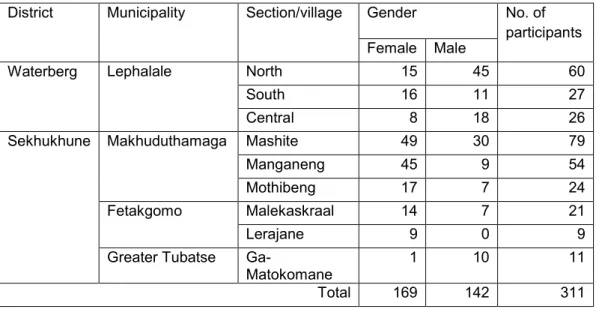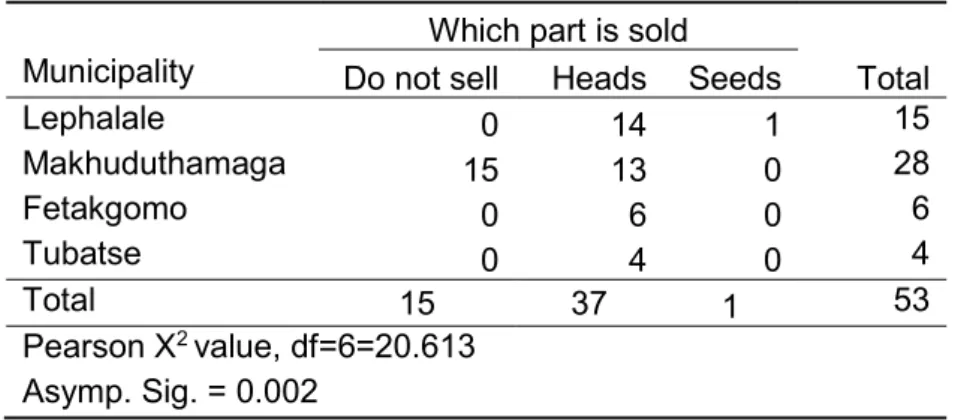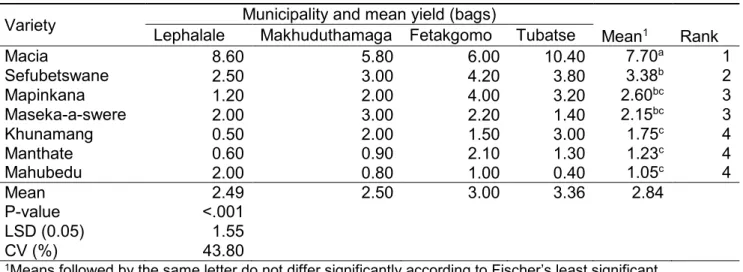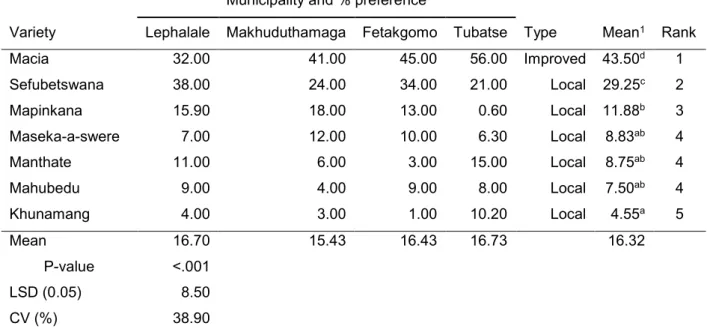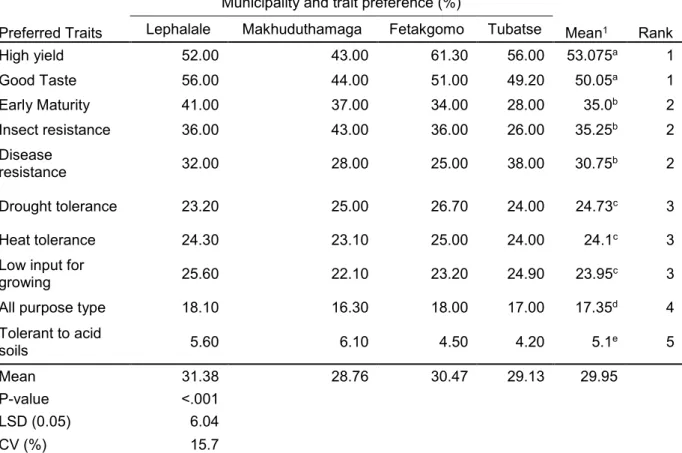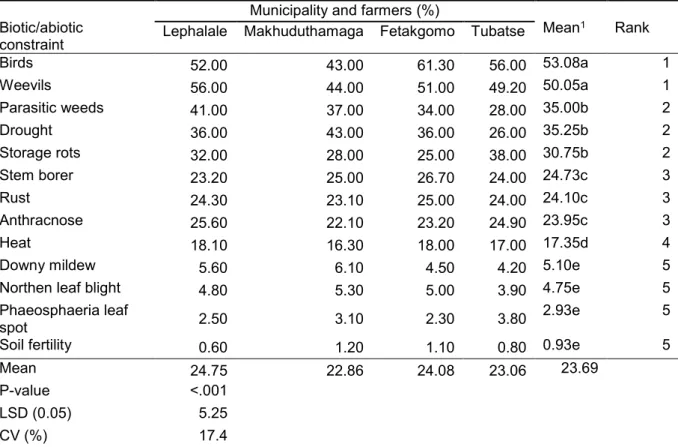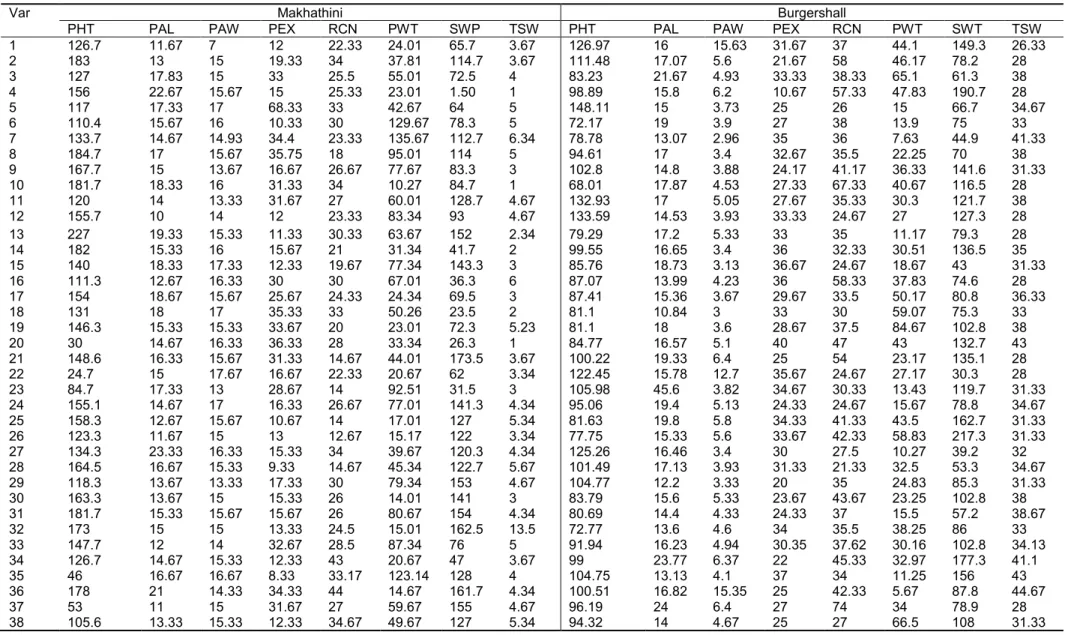To assess the level of genetic diversity present among South African sorghum genotypes using agromorphological traits. Genetic diversity exists for crude protein content and amino acid composition among South African sorghum genotypes.
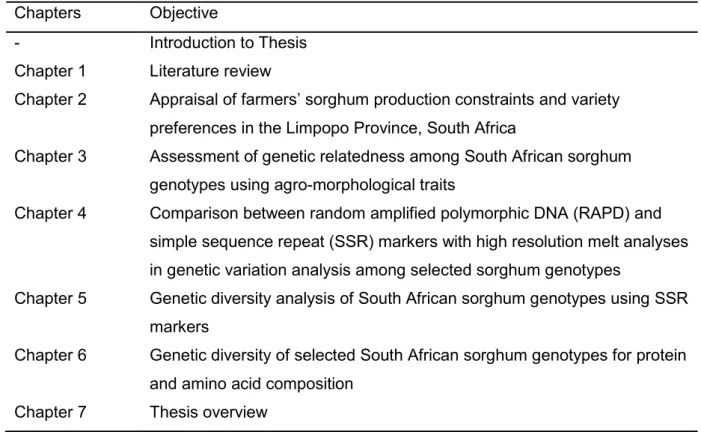
Introduction
Sorghum origin and domestication
Sorghum genetics and classification
Guinea sorghums are tall with loose spikes, spikes with open needles enclosing an elliptical grain and are sensitive to light period. Kaffir varieties are small sorghums with relatively compressed and cylindrical panicles consisting of symmetrical grains flattened on the ventral surface and convex on the dorsal part.
Constraints to sorghum production
Malnutrition-related diseases affect communities worldwide, but particularly in sub-Saharan Africa (FAO, 2010). Traditionally, crop improvement studies have focused on addressing environmental stresses, insect pests, and diseases. Recently, plant breeders have started breeding for improved nutritional quality traits such as increased levels of Fe and Zn, vitamins, starch, amino acids and proteins (Ashok et al., 2010; Sanjana et al., 2010).
Analysis of genetic diversity
Many studies have been conducted in breeding sorghum cultivars for increased drought tolerance, including the identification of component traits that influence drought tolerance (Khanna-Chopra and Sinha, 1988; Blum, 2011; Assefa, 2012). Breeding for improved nutrition has previously been neglected for many crops, including sorghum.
Sorghum characterisation and evaluation
- Morphological characterization of sorghum
- Molecular marker technology
- High resolution melt (HRM) analysis
Therefore, they can be used to study plant species in which previous methods have found little or no variation (Echt et al., 1998). According to Ciofi et al. 1998), polymerase enzyme slippage can yield products that differ by 1-5 repeat units.
Sorghum nutritional quality
- Protein content and amino acid composition in sorghum
The most important proteins found in sorghum are kafirins or prolamins, which make up approx. 80% of total grain protein (Taylor et al., 1984). Researchers have attempted to improve the nutritional quality of sorghum based on the identification of high-lysine mutants (Mertz et al., 1964; Nelson et al., 1965).
Genetic diversity of protein content and amino acids composition
The use of near-infrared spectroscopy (NIR) in the analysis of amino acid compositions has been reported in several studies (Olesen et al., 2011). The NIR technique can be used in the analysis of trans fatty acids of various milled grain products (Kim and Kays, 2009).
Participatory rural appraisal: farmer production constraints and variety preference
For example, farmers in the Lake Zone of Tanzania prefer sorghum varieties based on the color and flavor of sorghum ugali (Mafuru et al., 2007). Farmers in Ethiopia preferred sorghum varieties that were drought tolerant, resistant to Striga and produced good quality grain (Gebretsadik et al., 2014).
Summary
Multiple methods for identification of polymorphic simple sequence repeats (SSRs) in sorghum [Sorghum bicolor (L.) Moench]. Characteristics, linkage map positions, and allelic differentiation of Sorghum bicolor (L.) Moench DNA simple-sequence repeats (SSRs).
- Abstract
- Introduction
- Materials and methods
- Results and discussion
- Conclusions
- References
The surveyed farmers planted sorghum together with other cereals, pulses and vegetables in the studied areas (Table 2.7). Different forms of sorghum traded by smallholder farmers in four municipalities in Limpopo Province. The sorghum yield in the studied areas was expressed in the number of harvested bags (50 kg) per plot.
Sorghum in the study areas has become a successful staple crop for food and beer or for local industries.
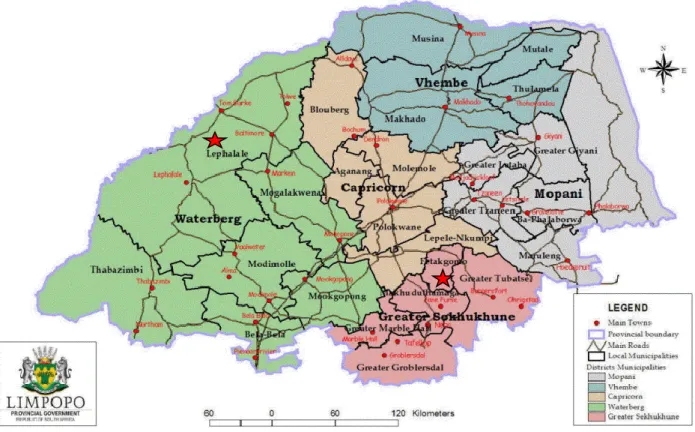
Abstract
Introduction
In addition, sorghum crop residues are a good source of animal feed and fodder (Rooney and Waniska, 2001; Chakauya et al., 2006). Previous studies have shown that sorghum is genetically diverse, with cultivated sorghums exhibiting high phenotypic variability (Rao et al., 1996; Aruna and Audilakshmi, 2008). A wide range of genetic diversity was observed among sorghum landraces in Cameroon (Barnaud et al. observed high phenotypic variability among sorghum landraces collected in Tamil Nadu.
In Kenya, Muraya et al. 2011) reported a wide range of morphological and structural diversity among wild sorghums.
Materials and methods
The phenotypic characterization and evaluation of sorghum genotypes depend on qualitative or quantitative morphological trait data (Upadhyaya et al used qualitative traits including leaf midrib color, grain color, grain color, endosperm texture, and panicle height , plant compactness, period, leaf area, leaf width, leaf length, number of leaves, panicle length, grain yield per plant, grain size, 1000-grain weight, number of grains per pod, width of leaf, number of primary branches per panicle and panicle weight (Punitha et al., 2010) The objective of the study was to assess the level of genetic diversity present among South African sorghum genotypes using agro-morphological traits.
Inflorescence shape and compactness were scored as 1 = very loose; 2 = very lax erect primary branches; 3 = very loose drooping primary branches; 4 = lax erect primary branches; 5 = loose drooping primary branches; 6 = semi-lax erect primary branches; 7 = semi-loose drooping primary branches; 8 = semi-condensed elliptic; 9 = compact elliptical; 10 = compact oval; 11 = broom corn; 12 = broom corn.
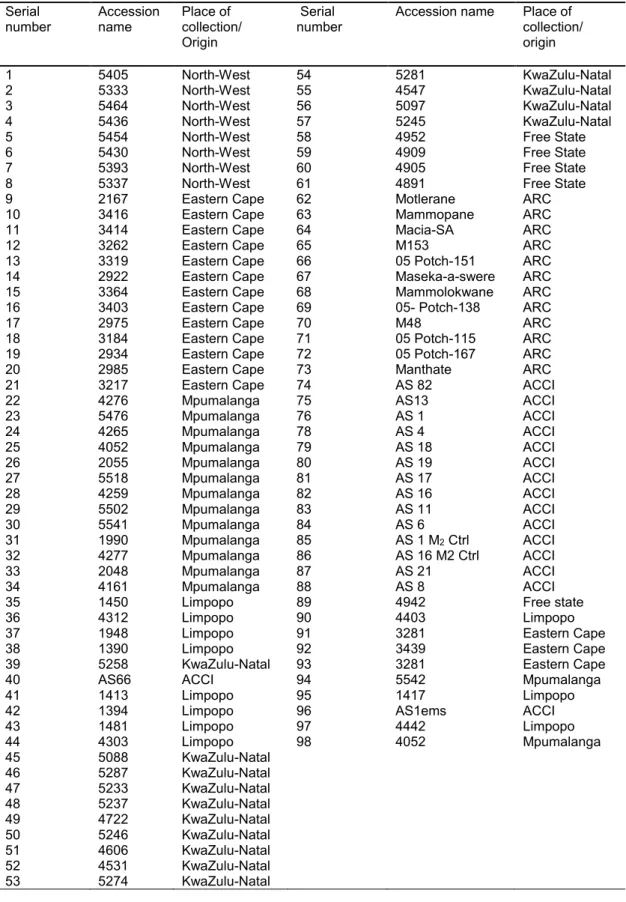
Results
There were highly significant differences (P < 0.001) between the sorghum genotypes for plant height in the Makhathini experiment (Table 3.4). Highly significant differences were recorded between the genotypes based on the weight of a thousand seeds (Table 3.4). Highly significant differences (P ≤ 0.001) were also observed between the genotypes in panicle length, rachis number, thousand seed weight and weight per panicle.
There were significant differences (P < 0.001) observed among the sorghum genotypes based on midrib color (Table 3.10).
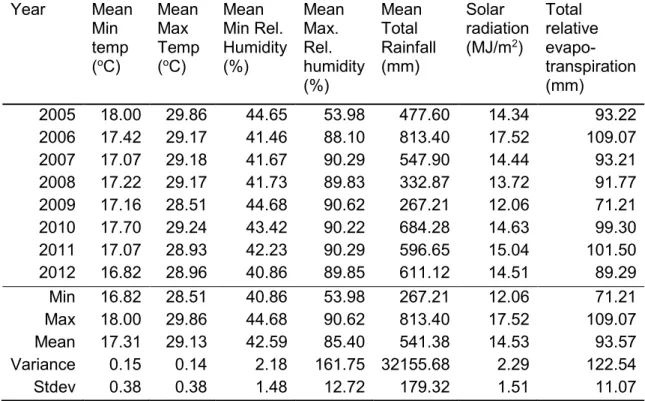
Discussion
Grain yield has also been reported elsewhere to be found to be positively correlated with plant height, panicle length and number of seeds per head (Chavan et al., 2011; Suliman and Abdelbagi (2010) further reported the presence of genetic diversity among the sorghum- accessions for Sudan This shows the presence of genetic diversity among the accessions within and among the South African provinces.
The results in this study are consistent with the study of Uptmoor et al. 2003) where the authors reported genetic diversity among the sorghum accessions, and the grouping of accessions was not based on place of origin or source.
Conclusions
Path coefficient and correlation assessment of yield and yield-related traits in sorghum (Sorghum bicolor L.). Biodiversity in plant, grain and nutritional characteristics of sorghum [Sorghum bicolor (L.) Moench] accession from Ethiopia and South Africa Department of Plant Sciences (Plant Breeding). Assessment of genetic diversity in sorghum accessions using qualitative morphological and amplified fragment length polymorphism markers.
Diversity assessment of sorghum germplasm and its use in genetic analysis of quantitative traits - A review.
- Abstract
- Introduction
- Materials and methods
- Results
- Discussion
- Conclusions
- References
The melting profiles are determined by the GC content, length and homozygosity and/or heterozygosity status of the sample genotypes (Reed et al., 2007). The HRM analysis demonstrated the existence of genetic variation among the sorghum genotypes when using SSR and RAPD primers. However, other studies reported that the use of the HRM assay was effective and efficient when used with other molecular markers (De Koeyer et al., 2010; Naidoo, 2010).
For example, Hofinger et al. 2009) reported the accuracy and sensitivity of the HRM analysis for predicting a wide range of nucleotide polymorphisms in barley.
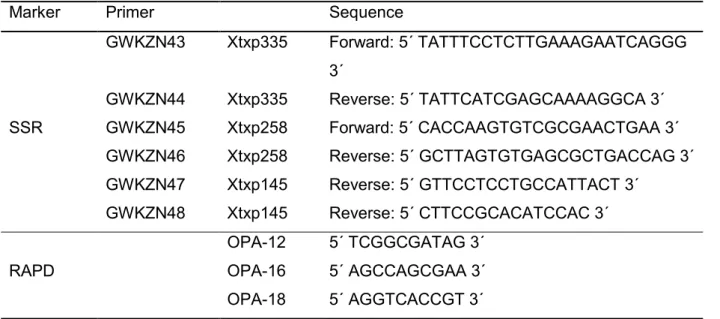
- Abstract
- Introduction
- Materials and methods
- Results and discussion
- Conclusions
- References
Several DNA-based marker systems have been successfully used to assess genetic diversity in sorghum (Nguni et al., 2011). In sorghum genetic diversity studies, a larger number of alleles (27) was reported by Muraya et al. According to Barnaud et al. 2007) farmers' practices and historical factors influence patterns of genetic diversity.
Assessment of genetic diversity and relationships among a US sweet sorghum germplasm collection using SSR markers.
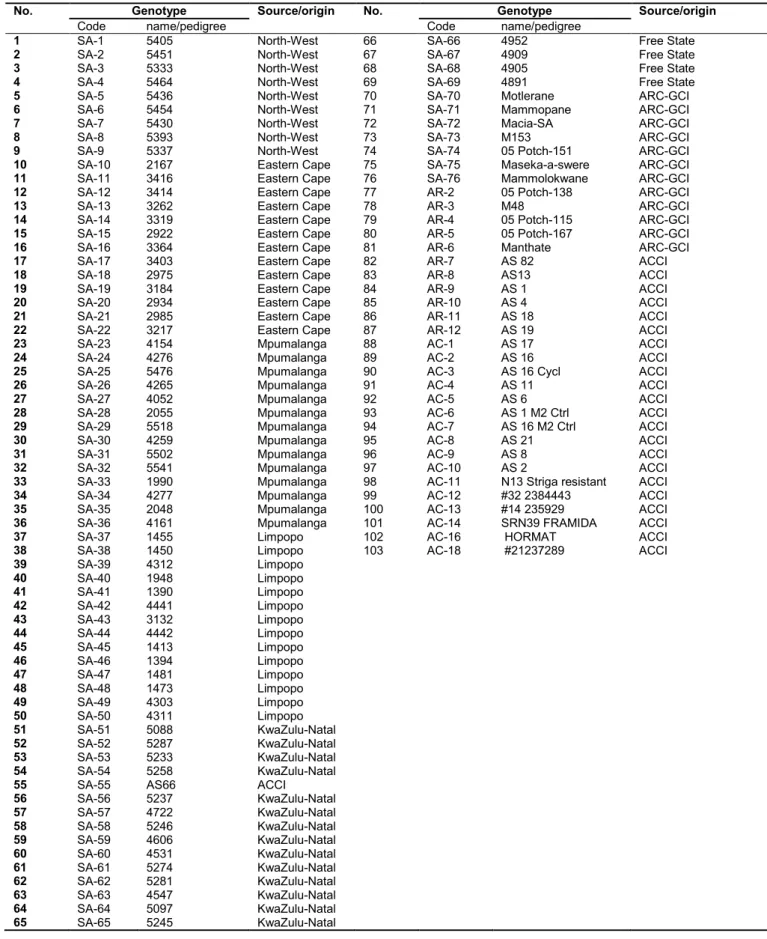
Abstract
Introduction
NIR has been used in several studies to determine protein and other nutritional quality attributes (YoungYi et al., 2010; Olesen et al., 2011). In other studies, the protein fraction in cereal crops such as sorghum was characterized by size exclusion, reverse phase HPLC and SDS-PAGE (Mokrane et al., 2009) and via in vitro protein digestibility of the extracted proteins (Mokrane et al., 2006). ). The methods used for the analysis of amino acids include ion exchange chromatography (Adeyeye, 2010), capillary electrophoresis (Waldhier et al., 2009), anion exchange chromatography with integrated pulsed amperometric (IPA) detection equipped with a gold electrode (Rombouts et al. al. , 2009) and high-performance liquid chromatography (HLPC) (Ilisz et al., 2008), among others.
It also allows structurally and chemically similar peptides and proteins to be differentiated (Ewles et al., 2010; Ewles and Goodwin, 2011; Nowatzke et al., 2011).
Materials and methods
The eppi samples were subjected to the Water AccQ Tag Ultra Derivitization Kit (Waters Corporation, MA, USA). A 10 µl undiluted sample was added to the Waters AccQ Tag Kit ingredients and placed in a heating block at a temperature of 55oC for ten minutes. The solvents, Eluent A2 contained 100 ml of Eluent A concentrate and 900 ml of water and Eluent B was provided in the AccQ Tag Kit.
The samples were run with the capillary voltage of 3.5 kilovolts (kV) and core voltage of 15 volts (V) at 120oC.
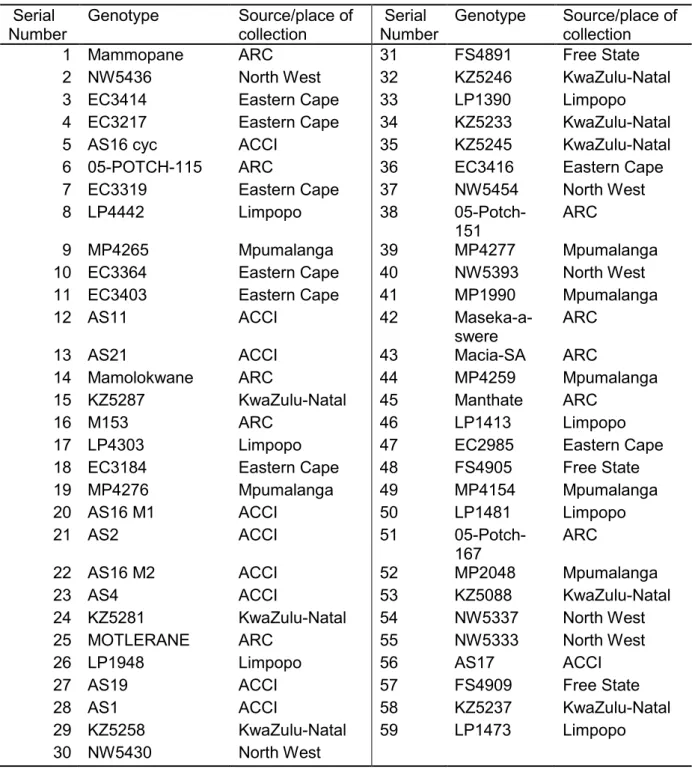
Results
The protein content and amino acid profiles of the genotypes were compared using the analysis of variance of the GenStat 14th edition computer package (Payne et al., 2011). The amino acid compositions of the 19 sorghum genotypes evaluated at Ukulinga are presented in Tables 6.5. These two genotypes have high protein and amino acid content useful for breeding and/or conservation.
Environmental factors such as location, chemical fertilizers, plant population and chemical treatment affect protein content and amino acid patterns (Salunkhe et al., 1977).
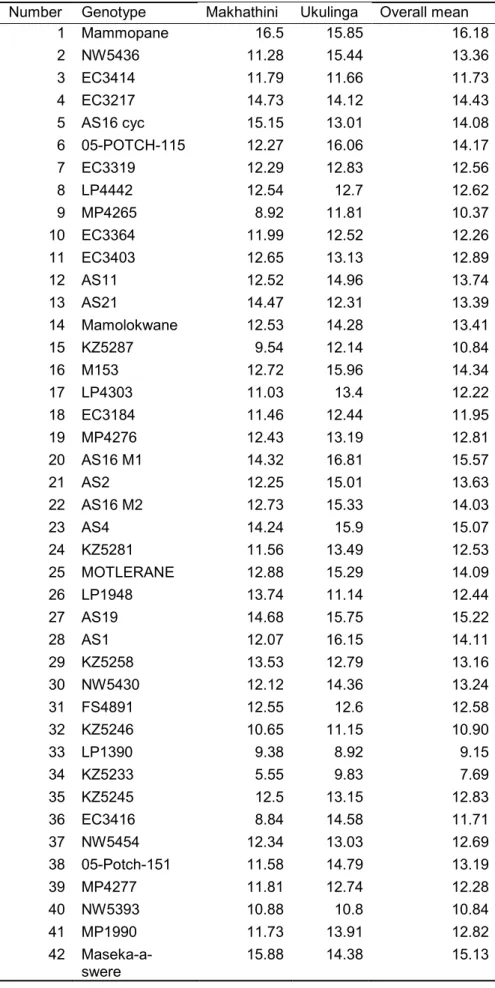
Conclusions
Amino acid content and availability of low, medium and high tannin sorghum grains for poultry. 2008 Application of chiral derivatizing agents in high-performance liquid chromatographic separation of amino acid enantiomers: a review. Evaluation of Algerian sorghum [Sorghum bicolor (L.) Moench] protein quality using amino acid analysis and in vitro pepin solubility.
Analysis of wheat gluten amino acid composition by high-performance anion exchange chromatography with integrated pulsed amperometric detection.
The clustering of sorghum accessions using SSR marker is very similar to the MHB analysis. iv) Genetic diversity analysis of sorghum genotypes using SSR markers in South Africa. Overall, the study established the existence of considerable genetic diversity among South African sorghum germplasm, phenotypically, genotypically and when using nutritional quality traits. How many bags do you need each year for the family's consumption? . i.. b)Do you sell your sorghum.
What are the sorghum production constraints you face in order of importance? (the constraints may be ranked to see their importance).
